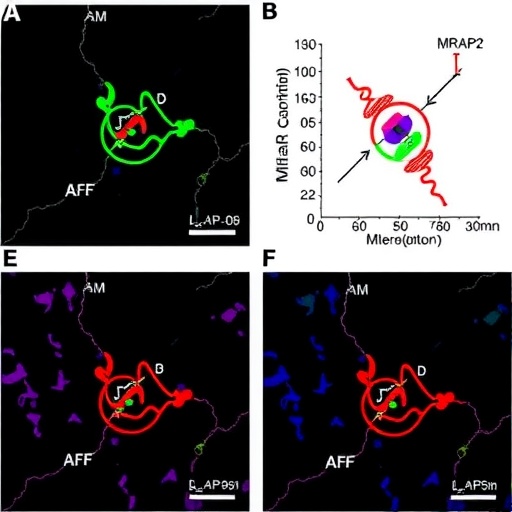In a groundbreaking new study published in Nature Communications, researchers have unveiled critical insights into how the Melanocortin-4 receptor (MC4R), a pivotal player in energy balance and appetite regulation, is modulated by the Melanocortin Receptor Accessory Protein 2 (MRAP2). The intricate interplay between MRAP2 and MC4R not only alters the receptor’s signaling pathways but also its oligomerization state, studies reveal, offering profound implications for metabolic disorders and obesity.
MC4R has long been known as a crucial receptor in the hypothalamus that controls feeding behavior and energy expenditure. Dysfunction or mutations in MC4R are among the most common genetic causes of obesity in humans, which makes understanding the receptor’s regulatory mechanisms of immense interest for developing targeted therapeutics. MRAP2, a single-transmembrane accessory protein, has emerged as a significant modulator of melanocortin receptors, but the precise molecular mechanics of its influence on MC4R have remained opaque until now.
This compelling investigation by Sohail et al. meticulously maps the multifaceted ways in which MRAP2 alters MC4R functionality. Using a combination of biophysical, biochemical, and pharmacological methods, the team elucidated how MRAP2 not only changes the strength and nature of MC4R’s intracellular signaling cascades but also impacts the receptor’s structural organization in the cell membrane. These findings challenge previously held notions that focused primarily on receptor-ligand binding, pivoting attention toward accessory protein-induced receptor dynamics.
The research took advantage of advanced methodologies such as Förster Resonance Energy Transfer (FRET) and bioluminescence resonance energy transfer (BRET) to reveal the oligomerization patterns of MC4R with or without MRAP2. The data demonstrate that MRAP2 influences the formation of MC4R homodimers and potentially higher-order oligomers, suggesting that the accessory protein stabilizes specific receptor conformations that are functionally distinct.
Intriguingly, these conformational changes induced by MRAP2 result in modified signaling profiles. The study found that MRAP2 presence enhances the coupling efficiency of MC4R to G-protein pathways associated with appetite suppression while simultaneously dampening beta-arrestin recruitment. This differential signaling bias may underlie the nuanced physiological outcomes seen in animal models, where MRAP2 expression levels correlate with feeding behavior and metabolic rates.
Further, researchers noted that MRAP2’s impact on MC4R extends beyond mere signal modulation; it also appears to orchestrate receptor trafficking and cell surface expression. Cells expressing MRAP2 showed significantly altered MC4R localization patterns, with more receptors present at the plasma membrane ready for ligand engagement. This suggests MRAP2 serves as a chaperone or scaffold, optimizing MC4R’s functional presence on the cell surface.
Structurally, MRAP2’s interaction with MC4R likely involves transmembrane and intracellular domain contacts that influence receptor folding and dynamics. Although the exact atomic arrangements remain to be resolved, computational modeling and mutagenesis experiments within the study imply that MRAP2 binding tilts MC4R toward active conformational states, thereby enhancing receptor responsiveness.
The physiological consequences of these molecular insights are far-reaching. By modulating MC4R’s signaling bias and oligomeric state, MRAP2 indirectly governs energy balance, feeding, and body weight homeostasis. Understanding this interaction opens potential therapeutic avenues, offering a novel target for obesity, where selective modulation of MC4R by MRAP2 or MRAP2 mimetics could fine-tune appetite suppression without the side effects of direct receptor agonists.
Moreover, the revelation of MRAP2’s role in receptor oligomerization expands our comprehension of GPCR biology. G-protein-coupled receptors (GPCRs) like MC4R are traditionally seen as monomeric or dimeric entities, yet the modulation by accessory proteins such as MRAP2 introduces a new layer of regulatory complexity that could be generalized to other receptor systems.
The implications for drug discovery are significant. Therapeutic agents designed to target MRAP2-MC4R interfaces could achieve a higher degree of specificity and safety by exploiting endogenous regulatory mechanisms rather than blunt receptor activation or inhibition. This could revolutionize treatment strategies for metabolic diseases where MC4R is implicated.
The study also provides a framework for re-examining the functional roles of accessory proteins in the wider GPCR superfamily, a family encompassing roughly 30% of all marketed drugs. The nuanced control these proteins exert over receptor conformation, trafficking, and signaling could be the key to unlocking better pharmacological profiles for many receptor targets.
Importantly, the research emphasizes the need for integrative approaches combining structure-function analysis with live-cell imaging and dynamic receptor monitoring. Such multidisciplinary perspectives allow a more physiologically relevant understanding of receptor behavior, moving beyond static views of receptor function.
On a broader scale, the findings highlight the intricate synergy between receptor core proteins and their accessory partners, shifting thinking from the receptor as an isolated unit to a component of dynamic, multiprotein complexes that define cellular responsiveness.
The convergence of cell biology, pharmacology, and structural biology in this study underscores the power of comprehensive research strategies in elucidating complex receptor regulation mechanisms. The efforts of Sohail et al. provide a blueprint for future endeavors targeting the modulation of GPCR activity via their accessory proteins.
As metabolic disorders continue to rise, understanding molecular check-points such as the MC4R-MRAP2 axis becomes vital. Elaborating these mechanisms promises not only innovative therapeutic interventions but also refined biomarker development, enabling personalized approaches to obesity and related metabolic conditions.
This pivotal research marks an exciting chapter in receptor biology, transforming our understanding of how accessory proteins sculpt GPCR function to influence fundamental physiological processes. It opens a promising frontier for translational science, where molecular insights directly fuel novel, targeted treatments.
In summary, the team’s revelations about MRAP2’s modulatory effects on MC4R’s signaling and oligomerization provide a compelling narrative on receptor regulation. This could ignite a paradigm shift in how scientists approach GPCR-targeted drug design, emphasizing accessory protein interactions as critical pharmacological targets for the future.
Subject of Research: Interaction between Melanocortin-4 Receptor (MC4R) and Melanocortin Receptor Accessory Protein 2 (MRAP2) and its effect on receptor signaling and oligomerization.
Article Title: MRAP2 modifies the signaling and oligomerization state of the melanocortin-4 receptor.
Article References:
Sohail, I., Laurin, S.A., Kleinau, G. et al. MRAP2 modifies the signaling and oligomerization state of the melanocortin-4 receptor. Nat Commun 16, 8324 (2025). https://doi.org/10.1038/s41467-025-63988-w
Image Credits: AI Generated
Tags: appetite control mechanismsbiochemical signaling pathwaysbiophysical analysis of receptorsenergy balance regulationhypothalamic feeding behaviorMelanocortin-4 receptor functionmetabolic disorder implicationsMRAP2 modulationobesity genetic causespharmacological methods in researchreceptor oligomerization statetargeted therapeutics development






